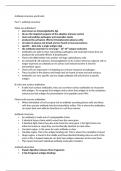Lecture notes
Antibody structure and B cells
- Module
- Mechanisms of pathology
- Institution
- Aston University, Birmingham (Aston)
preview:• also known as immunoglobulins (Ig) • Ab are the targeted weapons of the adaptive immune system • clear extracellular pathogens and neutralise toxins • produced by activated, effector B lymphocytes (plasma cells) • circulate in plasma and lymph and are found at mucosal surfac...
[Show more]



